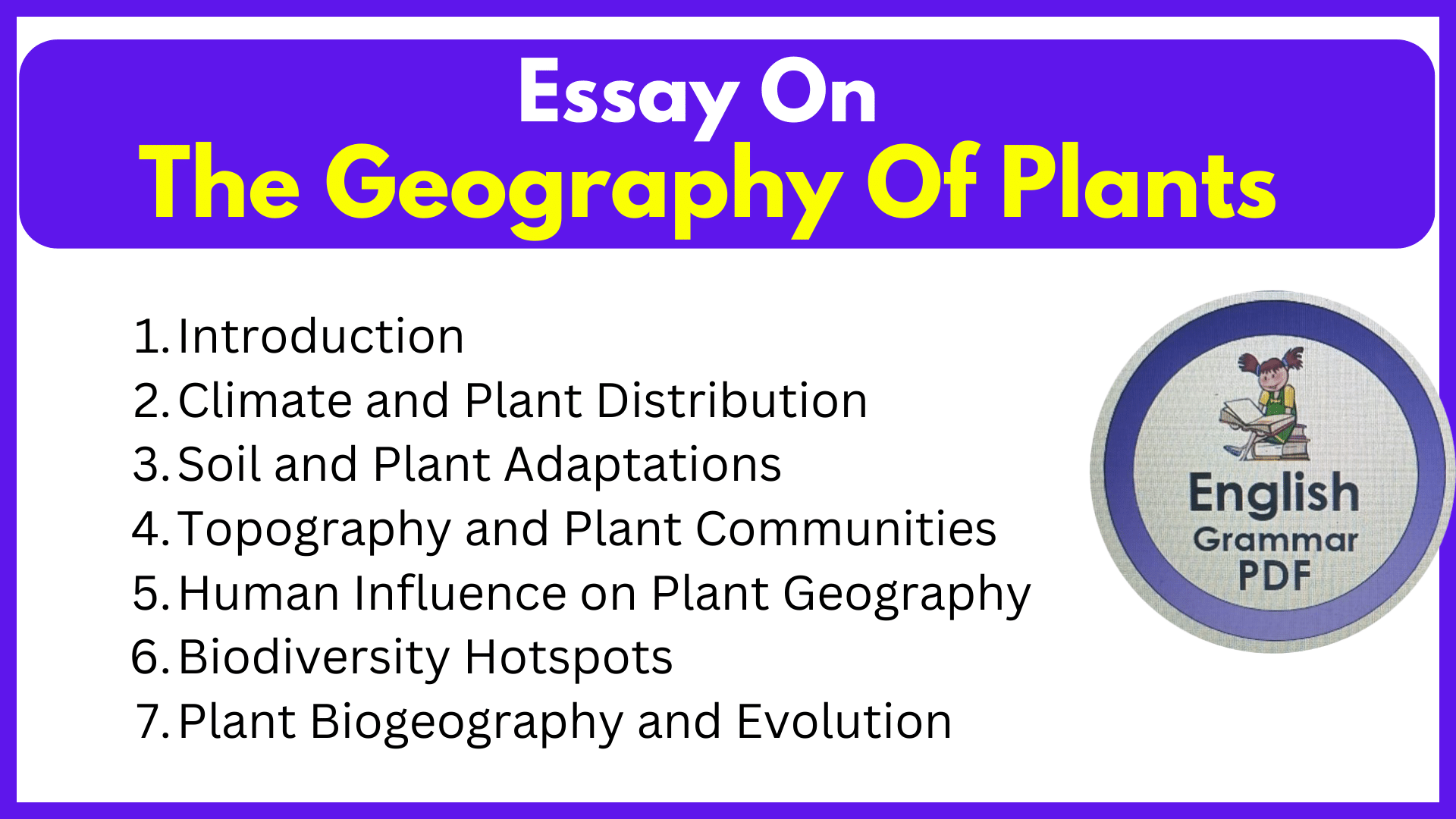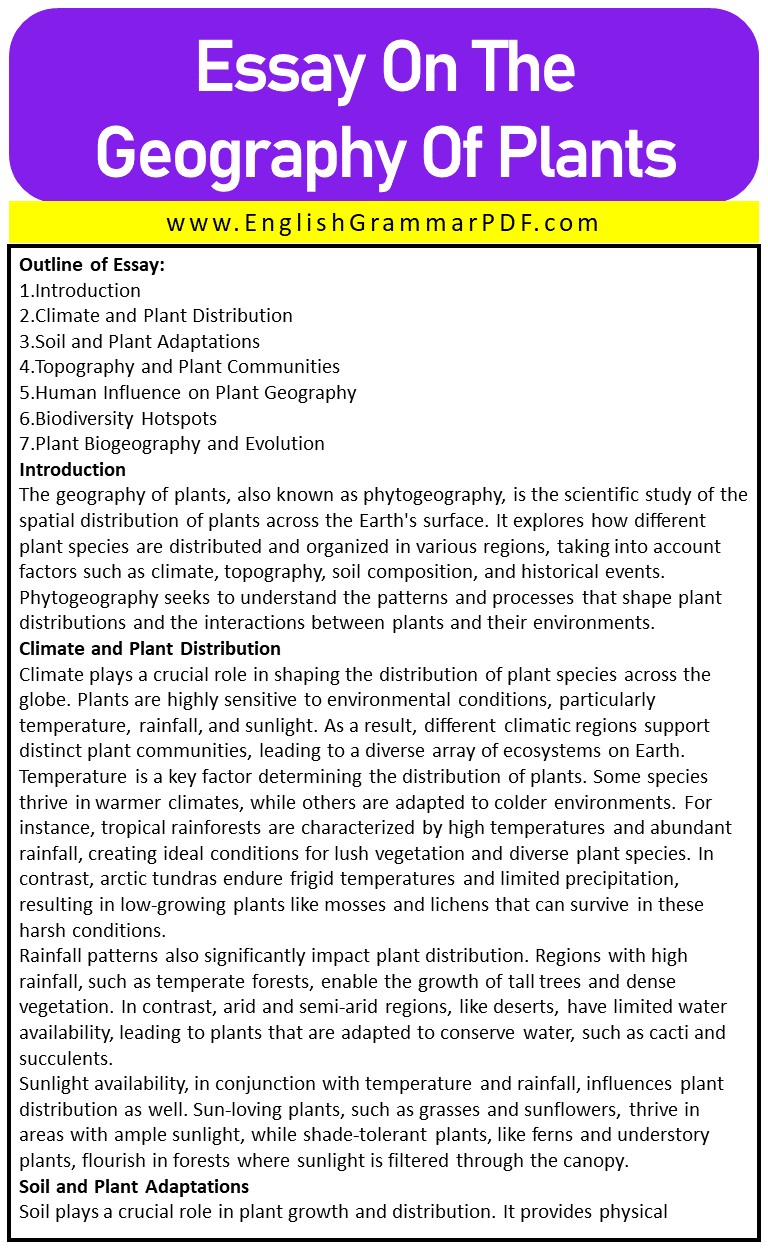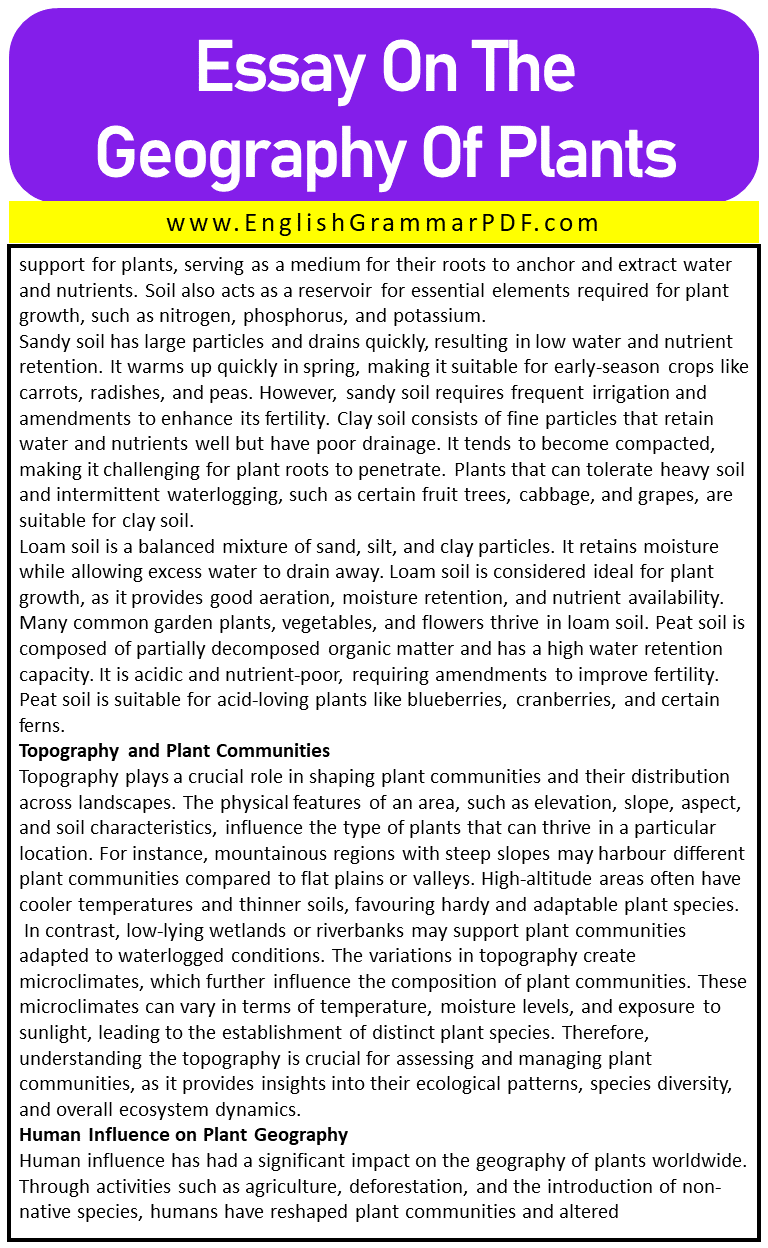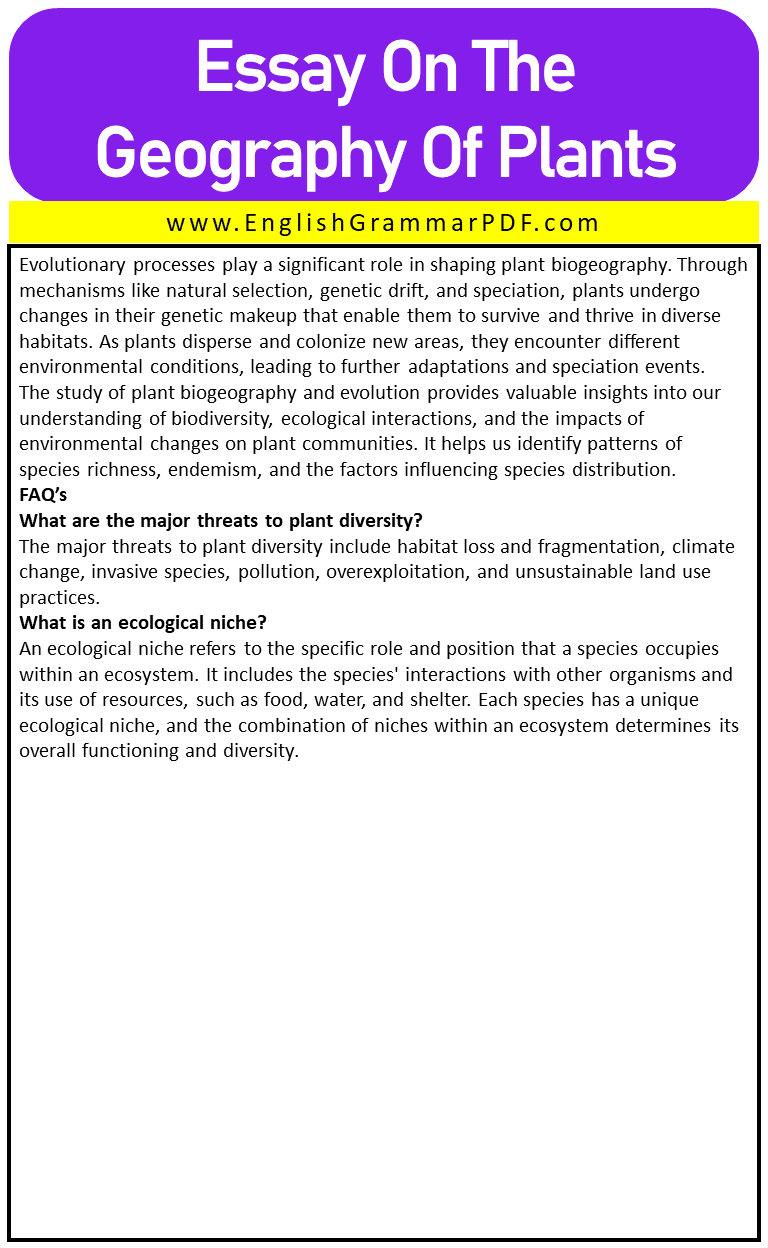Essay On The Geography Of Plants
Outline of Essay:
- Introduction
- Climate and Plant Distribution
- Soil and Plant Adaptations
- Topography and Plant Communities
- Human Influence on Plant Geography
- Biodiversity Hotspots
- Plant Biogeography and Evolution
Introduction
The geography of plants, also known as phytogeography, is the scientific study of the spatial distribution of plants across the Earth’s surface. It explores how different plant species are distributed and organized in various regions, taking into account factors such as climate, topography, soil composition, and historical events. Phytogeography seeks to understand the patterns and processes that shape plant distributions and the interactions between plants and their environments.
Climate and Plant Distribution
Climate plays a crucial role in shaping the distribution of plant species across the globe. Plants are highly sensitive to environmental conditions, particularly temperature, rainfall, and sunlight. As a result, different climatic regions support distinct plant communities, leading to a diverse array of ecosystems on Earth.
Temperature is a key factor determining the distribution of plants. Some species thrive in warmer climates, while others are adapted to colder environments. For instance, tropical rainforests are characterized by high temperatures and abundant rainfall, creating ideal conditions for lush vegetation and diverse plant species. In contrast, arctic tundras endure frigid temperatures and limited precipitation, resulting in low-growing plants like mosses and lichens that can survive in these harsh conditions.
Rainfall patterns also significantly impact plant distribution. Regions with high rainfall, such as temperate forests, enable the growth of tall trees and dense vegetation. In contrast, arid and semi-arid regions, like deserts, have limited water availability, leading to plants that are adapted to conserve water, such as cacti and succulents.
Sunlight availability, in conjunction with temperature and rainfall, influences plant distribution as well. Sun-loving plants, such as grasses and sunflowers, thrive in areas with ample sunlight, while shade-tolerant plants, like ferns and understory plants, flourish in forests where sunlight is filtered through the canopy.
Soil and Plant Adaptations
Soil plays a crucial role in plant growth and distribution. It provides physical support for plants, serving as a medium for their roots to anchor and extract water and nutrients. Soil also acts as a reservoir for essential elements required for plant growth, such as nitrogen, phosphorus, and potassium.
Sandy soil has large particles and drains quickly, resulting in low water and nutrient retention. It warms up quickly in spring, making it suitable for early-season crops like carrots, radishes, and peas. However, sandy soil requires frequent irrigation and amendments to enhance its fertility. Clay soil consists of fine particles that retain water and nutrients well but have poor drainage. It tends to become compacted, making it challenging for plant roots to penetrate. Plants that can tolerate heavy soil and intermittent waterlogging, such as certain fruit trees, cabbage, and grapes, are suitable for clay soil.
Loam soil is a balanced mixture of sand, silt, and clay particles. It retains moisture while allowing excess water to drain away. Loam soil is considered ideal for plant growth, as it provides good aeration, moisture retention, and nutrient availability. Many common garden plants, vegetables, and flowers thrive in loam soil. Peat soil is composed of partially decomposed organic matter and has a high water retention capacity. It is acidic and nutrient-poor, requiring amendments to improve fertility. Peat soil is suitable for acid-loving plants like blueberries, cranberries, and certain ferns.
Topography and Plant Communities
Topography plays a crucial role in shaping plant communities and their distribution across landscapes. The physical features of an area, such as elevation, slope, aspect, and soil characteristics, influence the type of plants that can thrive in a particular location. For instance, mountainous regions with steep slopes may harbour different plant communities compared to flat plains or valleys. High-altitude areas often have cooler temperatures and thinner soils, favouring hardy and adaptable plant species.
In contrast, low-lying wetlands or riverbanks may support plant communities adapted to waterlogged conditions. The variations in topography create microclimates, which further influence the composition of plant communities. These microclimates can vary in terms of temperature, moisture levels, and exposure to sunlight, leading to the establishment of distinct plant species. Therefore, understanding the topography is crucial for assessing and managing plant communities, as it provides insights into their ecological patterns, species diversity, and overall ecosystem dynamics.
Human Influence on Plant Geography
Human influence has had a significant impact on the geography of plants worldwide. Through activities such as agriculture, deforestation, and the introduction of non-native species, humans have reshaped plant communities and altered their distribution patterns. Agriculture, for instance, has led to the widespread cultivation of specific crops, resulting in the expansion of their range and the displacement of native species. Deforestation, driven by the need for land for agriculture, urbanization, and timber extraction, has destroyed vast forested areas, leading to the loss of countless plant species and disrupting ecosystems.
The introduction of non-native plant species, intentionally or inadvertently, has brought about invasive species that can outcompete and displace native plants, often causing ecological imbalances. Human activities have also facilitated the spread of plants through activities such as trade and transportation, allowing species to establish themselves in new areas far from their original range. The cumulative effects of human influence on plant geography have resulted in significant changes to ecosystems and pose ongoing challenges for conservation efforts and the preservation of biodiversity.
Biodiversity Hotspots
A biodiversity hotspot refers to a region that showcases exceptional levels of species richness and endemism, while simultaneously facing significant threats of habitat destruction and species extinction. These hotspots are typically characterized by a wide array of unique plant and animal species that are found nowhere else on Earth. They play a crucial role in maintaining the planet’s overall biodiversity and are often considered ecological treasures.
Biodiversity hotspots are usually concentrated in areas with high levels of biological productivity, such as tropical rainforests, coral reefs, and certain mountain ranges. These regions provide diverse habitats and favourable conditions for the evolution and survival of numerous species. However, they are also highly vulnerable to human activities like deforestation, pollution, and climate change.
Conservation efforts in biodiversity hotspots are essential for preserving the incredible variety of life forms and protecting the ecosystems they inhabit. By safeguarding these areas, we can prevent the irreversible loss of species and maintain the delicate balance of nature. Biodiversity hotspots serve as reminders of the beauty and complexity of our natural world and highlight the urgent need for sustainable practices to ensure their long-term survival.
Plant Biogeography and Evolution
Plant biogeography and evolution are intricately linked disciplines that shed light on the distribution and development of plant species across the globe. Biogeography examines the spatial patterns of plant species, investigating factors such as climate, geography, and dispersal mechanisms that shape their distribution. It explores questions of why certain species occur in specific regions and how they have evolved and adapted to their environments over time.
Evolutionary processes play a significant role in shaping plant biogeography. Through mechanisms like natural selection, genetic drift, and speciation, plants undergo changes in their genetic makeup that enable them to survive and thrive in diverse habitats. As plants disperse and colonize new areas, they encounter different environmental conditions, leading to further adaptations and speciation events.
The study of plant biogeography and evolution provides valuable insights into our understanding of biodiversity, ecological interactions, and the impacts of environmental changes on plant communities. It helps us identify patterns of species richness, endemism, and the factors influencing species distribution.
FAQ’s
What are the major threats to plant diversity?
The major threats to plant diversity include habitat loss and fragmentation, climate change, invasive species, pollution, overexploitation, and unsustainable land use practices.
What is an ecological niche?
An ecological niche refers to the specific role and position that a species occupies within an ecosystem. It includes the species’ interactions with other organisms and its use of resources, such as food, water, and shelter. Each species has a unique ecological niche, and the combination of niches within an ecosystem determines its overall functioning and diversity.
Explore More Essays:
Essay On The Future Of Technology
Essay On My Journey Of Self Discovery
Download the PDF of the Essay:







